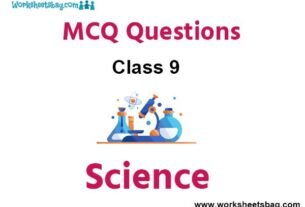Please refer to Diversity in Living Organisms MCQ Questions Class 9 Science below. These MCQ questions for Class 9 Science with answers have been designed as per the latest NCERT, CBSE books, and syllabus issued for the current academic year. These objective questions for Diversity in Living Organisms will help you to prepare for the exams and get more marks.
Diversity in Living Organisms MCQ Questions Class 9 Science
Please see solved MCQ Questions for Diversity in Living Organisms in Class 9 Science. All questions and answers have been prepared by expert faculty of standard 9 based on the latest examination guidelines.
MCQ Questions Class 9 Science Diversity in Living Organisms
OBJECTIVE QUESTIONS
Question. The most primitive vascular plants are
(a) Cycas
(b) ferns
(c) moss
(d) brown algae
Answer
B
Question. Find the correct statement.
(a) Two parts of binomial nomenclature are generic and trivial names.
(b) Generic = genus, trivial names = specific, should precede by generic name.
(c) Genus name is capitalized, species name is not
(d) All of the above
Answer
D
Question. Which of the following is not a chondrichthyes?
(a) Scoliodon
(b) Sting ray
(c) Hippocampus
(d) Torpedo
Answer
C
Question. Match the columns and select the correct option.

(a) A-3, B-2, C-1
(b) A-1, B-3, C-2
(c) A-2, B-3, C-1
(d) A-3, B-1, C-2
Answer
B
Question. In which of the following groups, chlorophyll is not present?
(a) Algae
(b) Fungi
(c) Bryophyta
(d) Pteridophyta
Answer
B
Question. Identify the pictures given below.
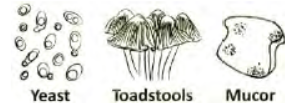
(a) Bryophytes
(b) Algae
(c) Pteridophytes
(d) Fungi
Answer
D
Question. Water vascular system is a distinctive feature of
(a) Echinodermata
(b) Annelida
(c) Chordata
(d) Mollusca
Answer
A
Question. In which of the following groups, would you place a plant which produces spores and embryos but lacks seeds and vascular tissues?
(a) Fungi
(b) Pteridophytes
(c) Bryophytes
(d) Gymnosperms
Answer
C
Question. Which group of animals are called ‘flatworms’ ?
(a) Platyhelminthes
(b) Porifera
(c) Coelenterata
(d) Nematoda
Answer
A
Question. Which of the following represent the lowermost category in the taxonomic hierarchy?
(a) Genus
(b) Species
(c) Order
(d) Phylum
Answer
B
Question. Which of the following is a plant that produce seeds but not fruits?
(a) Fungi
(b) Bryophytes
(c) Pteridophytes
(d) Gymnosperms
Answer
C
Question. Why is the animal shown below not classified as an insect?
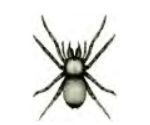
(a) It does not have six legs
(b) It has two body parts
(c) If feeds on insects
(d) Both (a) and (b)
Answer
D
Question. What is the purpose of classifying organisms?
(a) Classification facilitates the identification.
(b) By studying a few-organisms, the characteristics of the whole group can be known.
(c) Classification helps to establish the relationship among various groups of organisms.
(d) All of these
Answer
D
Question. What is classification?
(a) Grouping organisms together on the basis of the features they have in common.
(b) Grouping organisms together of the basis of how they respire.
(c) Grouping organisms together on the basis of how they feed.
(d) Grouping organisms together on the basis of how they survive.
Answer
A
Question. Which of the following statements is incorrect?
(a) Organisms with primitive body structure are lower organisms.
(b) Older organisms have simpler body structure.
(c) Younger organisms are relatively recent organisms in term of evolutionary time.
(d) Advanced organisms have more complex body structure.
Answer
A
Question. Binomial Nomenclature includes
(a) only species name
(b) both genus and species name
(c) only genus name
(d) both genus and family name
Answer
B
Question. Organism that does not have a defined nucleus and live in symbiotic relationship with fungi. It belongs to kingdom
(a) Protista
(b) Monera
(c) Fungi
(d) Plantae
Answer
B
Question. Select the descending order of nomenclature.
(a) Kingdom-division-class-order-genus-species
(b) Kingdom-class-order-phylum-species-genus
(c) Kingdom-phylum-class-order-family-genus-species
(d) Kingdom-phylum-order-class-genus-species
Answer
C
Question. What is meant by biodiversity?
(a) A large population of animals in a habitat
(b) A large population of plants in a habitat
(c) A large variety of living things
(d) An interactions between plants and animals
Answer
C
FILL IN THE BLANK
Question. In birds ………. are modified to form a strong beak.
Answer
Jaws
Question. ………. are plants with naked seeds.
Answer
Gymnosperms
Question. Triploblastic, acoelomate and bilaterally symmetrical animals are placed in ……….
Answer
Platyhelminthes
Question. Bacteria, blue-green algae are included in the kingdom ……….
Answer
Monera
Question. Blood fluke belongs to the phylum ……….
Answer
Platyhelminthes
Question. ………. are also called vascular cryptogams.
Answer
Pteridophytes
Question. ………. are considered as amphibians of plant kingdom.
Answer
Bryophytes
TRUE/FALSE
Question. Ferns are seedless plants.
Answer
True
Question. Animals store carbohydrate as glycogen.
Answer
True
Question. Hornworts and liverworts are pteridophytes.
Answer
False
Question. The algae are vascular system.
Answer
False
Question. Lichens are examples of liverworts.
Answer
False
MATCHING QUESTIONS
Question.
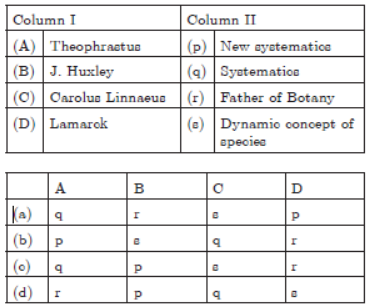
Answer
(d) A-r, B-p, C-q, D-s
Question.
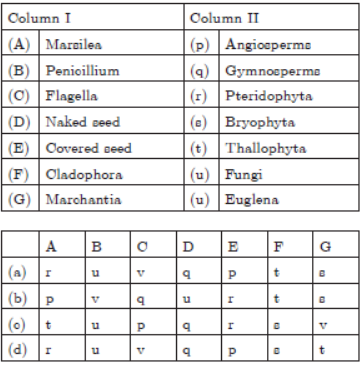
Answer
(a) A-r, B-u, C-v, D-q, E-p, F-t, G-s
Question.
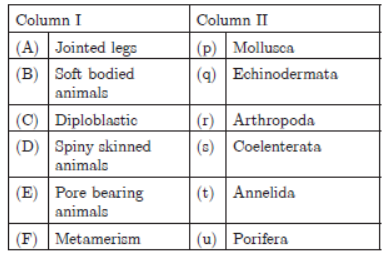
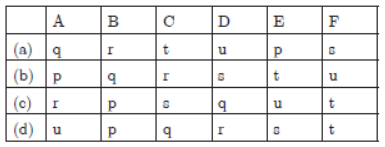
Answer
(c) A-r, B-p, C-s, D-q, E-u, F-t
ASSERTION AND REASON
Question. Assertion : Seeds are enclosed within fruits in gymnosperms.
Reason : Ovules are enclosed within ovary in gymnosperms.
Options:
(a) Both assertion and reason are true and reason is the correct explanation of assertion.
(b) Both assertion and reason are true but reason is not the correct explanation of assertion.
(c) Assertion is true but reason is false.
(d) Both Assertion and Reason are false.
Answer
D
Question. Assertion : The process of classification is based on certain characters to divide organisms into broad groups.
Reason : Cells occur singly or in clusters is the basic characteristic of classification.
Options:
(a) Both assertion and reason are true and reason is the correct explanation of assertion.
(b) Both assertion and reason are true but reason is not the correct explanation of assertion.
(c) Assertion is true but reason is false.
(d) Both Assertion and Reason are false.
Answer
C
Question. Assertion : Fish are cold-blooded animals.
Reason : Fish hearts have two auricles and two ventricles.
Options:
(a) Both assertion and reason are true and reason is the correct explanation of assertion.
(b) Both assertion and reason are true but reason is not the correct explanation of assertion.
(c) Assertion is true but reason is false.
(d) Both Assertion and Reason are false.
Answer
C
Question. Assertion : Platyhelminthes are commonly called flatworms.
Reason : Plathelminthes are elongated, dorsoventrally flattened animals.
Options:
(a) Both assertion and reason are true and reason is the correct explanation of assertion.
(b) Both assertion and reason are true but reason is not the correct explanation of assertion.
(c) Assertion is true but reason is false.
(d) Both Assertion and Reason are false.
Answer
A
Question. Assertion : Bryophytes are called amphibians of plant kingdom.
Reason : In bryophytes, water is required for fertilization.
Options:
(a) Both assertion and reason are true and reason is the correct explanation of assertion.
(b) Both assertion and reason are true but reason is not the correct explanation of assertion.
(c) Assertion is true but reason is false.
(d) Both Assertion and Reason are false.
Answer
A

